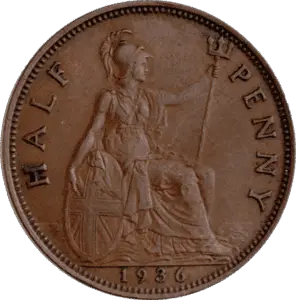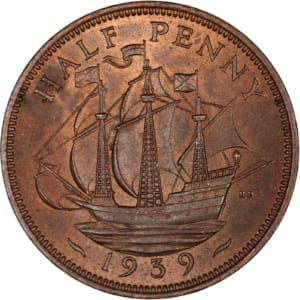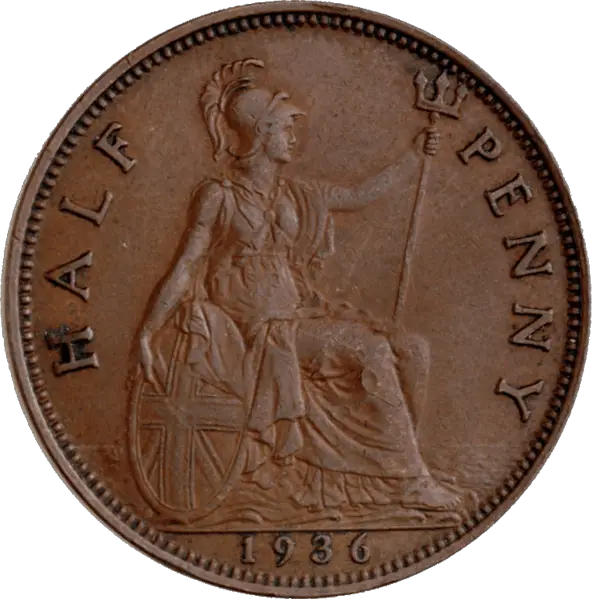The British pre-decimal halfpenny coin was often referred to as the half penny or halfpenny. This was a unit of currency that was equal to half a penny or one-four-hundred-and-eightieth of a pound sterling. If you are more interested in learning about the decimal halfpenny, issued in 1971, please read our article here about it!
Below, we will reveal everything that you need to know about this coin, as well as provide you with a bit of history regarding this currency and how it was used.
Understanding pre-decimal coins
Before we reveal more about the pre-decimal halfpenny coin, it is important to give you a bit of the back story regarding pre-decimal coins so that you can get a better understanding.
Despite the fact that it has been around 50 years since decimalisation occurred, the names of the old pre-decimalisation coins can be seen and heard everywhere. This includes proverbs, songs, idioms, nursery rhymes, and old works of literature.
Prior to decimalisation, money was divided into the following:
- Pennies (d.)
- Shillings (s. or /-)
- Pounds (£ or l )
The penny was then decided into more sub-divisions, into two halfpennies or four farthings (quarter pennies).
- 12 pence = 1 shilling (a bob) (1s)
- 2 shillings = 1 florin ( a ‘two bob bit’) (2s)
- 2 shillings and 6 pence = 1 half crown (2s 6d)
- 5 shillings = 1 Crown (5s)
- 2 farthings = 1 halfpenny
- 2 halfpence = 1 penny (1d)
- 3 pence = 1 thruppence (3d)
- 6 pence = 1 sixpence (a ‘tanner’) (6d)
These coins may have been demonetised but they play a critical role in the culture in Britain today.
What is decimalisation?
Decimalisation is a term that comes from Decimal Day, which took place in Ireland and the United Kingdom on the 15th of February 1971. This is the day whereby each country decimalised its respective £sd currency of pence, shillings, and pounds.
Prior to this date, the British pound was made up of 20 shillings, each of which was made up of 12 pence, totalling 240 pence.
With decimalisation, the pound kept its old name and value, with the changes made to the subunits. The shilling was abolished and the pound was then divided into 100 new pence.
What is the British halfpenny?
The pre-decimal halfpenny coin was a unit of currency that was minted from 1672 until 1967. In the run-up to decimalisation, it ceased to be legal tender from the 31st of July in 1969, being replaced by the eventual decimal halfpenny.
The halfpenny was colloquially spoken as “a penny ha’penny” and written as ha’penny. It was a small, circular coin, with smooth edges.
‘If you haven’t got a penny,
A ha’penny will do;
If you haven’t got a ha’penny,
Then God bless you!’
This is taken from the Christmas chant “Christmas is coming.” There are many other ways that half pennies have been immortalised as well. This includes the idiom ‘spoil the ship for a ha’p’orth of tar’. In other words, the ‘ha’p’orth’ is a contraction of ‘half penny’s worth’ and the idiom means to spoil a job by being stringy with regard to the details.
What did the pre-decimal halfpenny look like?
The original halfpenny was minted in copper. However, this was then switched to bronze in 1860.
The pre-decimal halfpenny had two different designs while it was in circulation. Initially, the image of Britannia was on the reverse. This was from 1672 all the way through until 1936.

After this, the Golden Hind appeared. Like all coinage in Britain, on the observe, there was a portrait of the monarch and a legend in Latin.

The original Britannia design
The original reverse version of the bronze coin featured a seated Britannia holding a trident. This was designed by Leonard Charles Wyon. The coin had the words “half penny” to either side.
There was also a lighthouse to the left of the Britannia on coins that were issued prior to 1895, as well as a ship to her right.
There have been a number of very small adjustments that have been made to the level of the area around the Britannia over the years. Small changes to the angle of the trident were also made.
Different obverses used over the years
There have also been numerous obverses that have been used over the years. Elizabeth II, George VI, George V, and Edward VII had a single obverse of halfpennies created during their respective reigns.
There were two different obverses that were used during the long reign of Queen Victoria. However, as Edward VIII only reigned for a short time, there were never any halfpennies that bore his likeness in issue.
During the reign of Queen Victoria, the first issue was the one with the ‘draped bust’ or ‘bun head’ of Queen Victoria on the obverse, as they were referred to. The inscription read ‘VICTORIA D G BRITT REG F D’ around the bust. However, it was then replaced by the ‘veiled bust’ or the ‘old head’ in 1895. The inscription read ‘VICTORIA DEI GRA BRITT REGINA FID DEF IND IMP’ on these coins.
Throughout the reign of Edward VII, coins were issued that featured his likeness and they had the following inscription: ‘EDWARDVS VII DEI GRA BRITT OMN REX FID DEF IND IMP’.
The same occurred during the reign of George V, featuring him and the inscription ‘GEORGIVS V DEI GRA BRITT OMN REX FID DEF IND IMP.’
There is a pre-decimal halfpenny of King Edward VIII (1936) in existence, and it is dated 1937. However, this is a pattern coin technically, which means it is one that has been created for official approval. In all likelihood, it would have been due to receive the King’s approval around the time of the abdication of the King.
The observe shows a portrait of the king, which is left-facing. This is not a surprise when you consider that King Edward VIII deemed this his best side! Because of this, it broke the tradition of alternative directions being used. At the time, some people believed that this indicated bad luck for his reign. On the observe, the inscription was ‘EDWARDVS VIII D G BR OMN REX F D IND IMP.’
The regular issue pre-decimal halfpenny of Elizabeth II and George VI, as well as the pattern coin of Edward VIII, feature a redesigned reverse that displays the Golden Hind ship of Sir Francis Drake.
Finally, we will tell you a little bit about the coin issued during the reign of George VI. The first coin, which was in circulation before 1949 had the inscription ‘GEORGIVS VI D G BR OMN REX F D IND IMP.’ After this, the inscription was ‘GEORGIVS VI D G BR OMN REX FIDEI DEF.’
Unlike the penny, the pre-decimal halfpennies were minted throughout Elizabeth II’s early reign. They bore the inscription ‘ELIZABETH II DEI GRA BRITT OMN REGINA F D’ in 1953, and this was followed by ‘ELIZABETH II DEI GRATIA REGINA F D’.
The continuance of the halfpenny after decimalisation
The curious thing about the halfpenny, though, is not that it was abolished during decimalisation like other coins such as the shilling. The pre-decimal halfpenny was discontinued technically and replaced by a ‘decimal halfpenny‘, essentially the same coin.
When we look back at the coins that were in circulation throughout the years, a lot of people hold the halfpenny with a lot of affection, and rightly so! However, it was not always the way for the halfpenny. In fact, the tiny coin was a source of annoyance for a lot of people. If you think you often lose pennies in your sofa or trouser pocket today, you have experienced nothing like the halfpenny!
In 1983, the National Consumer Council told the Herald Tribune that the coin was “useless” in terms of coins in your pocket. Also, newsstand workers and vendors complained that while they could take the pre-decimal halfpenny off customers, they weren’t able to hand any out.
In the Times’ letter pages, you would often find complaints and remarks about the pifflingness of the coin. In 1945, Pamela Johnson wrote the following:
“Sir, I can scarcely believe that writers of letters bemoaning the demise of the halfpenny coin, because they would not be able to deal with some small-apertured possession without it, are being serious.”
Nigel Lawson, who was Chancellor during 1984, wrote a letter to the Commons asking for the coin to be removed. He stated that most people would be happy to get rid of the coin. It was then at the end of February that the Royal Mint stopped making the coins, ceasing to be a legal tender in December of the year.
Final words
So there you have it: an insight into the pre-decimal halfpenny. For any coin collector, this is a must-have for your collection. Not only are these coins fascinating to look at, but they tell a story of what Britain was like during these years.
